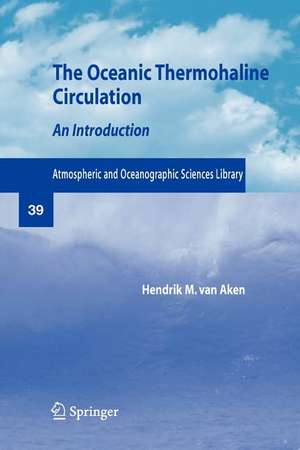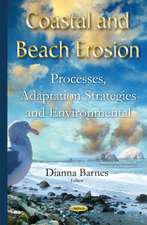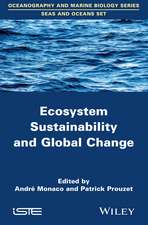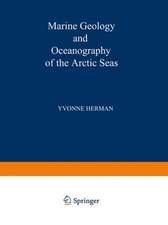The Oceanic Thermohaline Circulation: An Introduction: Atmospheric and Oceanographic Sciences Library, cartea 39
Autor Hendrik M. van Akenen Limba Engleză Paperback – 23 noi 2010
| Toate formatele și edițiile | Preț | Express |
|---|---|---|
| Paperback (1) | 946.87 lei 6-8 săpt. | |
| Springer – 23 noi 2010 | 946.87 lei 6-8 săpt. | |
| Hardback (1) | 951.29 lei 6-8 săpt. | |
| Springer – 4 dec 2006 | 951.29 lei 6-8 săpt. |
Din seria Atmospheric and Oceanographic Sciences Library
- 18%
 Preț: 1996.98 lei
Preț: 1996.98 lei - 18%
 Preț: 957.75 lei
Preț: 957.75 lei - 18%
 Preț: 963.15 lei
Preț: 963.15 lei - 18%
 Preț: 1156.64 lei
Preț: 1156.64 lei - 18%
 Preț: 948.61 lei
Preț: 948.61 lei - 18%
 Preț: 946.55 lei
Preț: 946.55 lei - 18%
 Preț: 1224.18 lei
Preț: 1224.18 lei - 18%
 Preț: 1226.90 lei
Preț: 1226.90 lei - 18%
 Preț: 952.26 lei
Preț: 952.26 lei - 15%
 Preț: 639.90 lei
Preț: 639.90 lei - 18%
 Preț: 1229.58 lei
Preț: 1229.58 lei - 18%
 Preț: 1418.98 lei
Preț: 1418.98 lei - 18%
 Preț: 950.66 lei
Preț: 950.66 lei - 24%
 Preț: 801.40 lei
Preț: 801.40 lei - 18%
 Preț: 1237.30 lei
Preț: 1237.30 lei - 18%
 Preț: 1225.79 lei
Preț: 1225.79 lei - 18%
 Preț: 960.42 lei
Preț: 960.42 lei - 18%
 Preț: 1392.46 lei
Preț: 1392.46 lei - 18%
 Preț: 947.18 lei
Preț: 947.18 lei - 18%
 Preț: 1235.76 lei
Preț: 1235.76 lei - 18%
 Preț: 1541.47 lei
Preț: 1541.47 lei - 18%
 Preț: 1390.59 lei
Preț: 1390.59 lei - 18%
 Preț: 1226.73 lei
Preț: 1226.73 lei - 18%
 Preț: 974.67 lei
Preț: 974.67 lei - 18%
 Preț: 952.40 lei
Preț: 952.40 lei - 18%
 Preț: 954.45 lei
Preț: 954.45 lei -
 Preț: 390.25 lei
Preț: 390.25 lei - 20%
 Preț: 585.98 lei
Preț: 585.98 lei
Preț: 946.87 lei
Preț vechi: 1154.72 lei
-18% Nou
Puncte Express: 1420
Preț estimativ în valută:
181.21€ • 188.48$ • 149.60£
181.21€ • 188.48$ • 149.60£
Carte tipărită la comandă
Livrare economică 12-26 aprilie
Preluare comenzi: 021 569.72.76
Specificații
ISBN-13: 9781441922687
ISBN-10: 1441922687
Pagini: 348
Ilustrații: XVIII, 326 p. 153 illus.
Dimensiuni: 155 x 235 x 18 mm
Greutate: 0.49 kg
Ediția:Softcover reprint of hardcover 1st ed. 2007
Editura: Springer
Colecția Springer
Seria Atmospheric and Oceanographic Sciences Library
Locul publicării:New York, NY, United States
ISBN-10: 1441922687
Pagini: 348
Ilustrații: XVIII, 326 p. 153 illus.
Dimensiuni: 155 x 235 x 18 mm
Greutate: 0.49 kg
Ediția:Softcover reprint of hardcover 1st ed. 2007
Editura: Springer
Colecția Springer
Seria Atmospheric and Oceanographic Sciences Library
Locul publicării:New York, NY, United States
Public țintă
ResearchCuprins
The ocean basins.- Pressure, temperature, salinity, and some thermohaline dynamics.- Water mass and tracer analysis of the deep flow in the Atlantic Ocean.- The deep flow in the Southern, Indian, and Pacific oceans.- The upper branch of the THC.- Formation and descent of water masses.- Dynamics of the THC.- Deep upwelling and mixing.- Energetics of the THC.- Simple models, boundary conditions, and feedbacks.- The THC and different climates.
Recenzii
From the reviews:
"Van Aken (Royal Netherlands Institute for Sea Research) introduces THC to students in physical oceanography and related fields who can do simple math. … Appropriate for undergraduate oceanography or research library collections. … Summing Up: Recommended. Lower- and upper-division undergraduates; faculty and researchers." (L. S. Zipp, CHOICE, Vol. 44 (11), July, 2007)
"This book presents various aspects of the world ocean thermohaline circulation (THC) … . My conclusion is that the book represents a rather complete and well done evaluation of the THC; it can be used by students of different backgrounds … . More especially, it can be useful for M.Sc. and Ph.D. students in oceanography, and to a certain extent also for students in meteorology as additional textbook. … I recommend the book warmly to oceanography graduate students." (Miroslav Gacic, Journal of Sedimentary Research, November, 2007)
"In this book, Hendrik van Aken provides descriptions of the thermohaline circulations (based on observations), of the essential aspects of its coupling to the atmosphere, and of its dynamics. … The Oceanic Thermohaline Circulation: An Introduction could be used in a university course in oceanography, particularly as a primer for inspiring numerical modelers, who often need to know more about the ocean." (Arnold L. Gordon, Bulletin of the American Metrological Society, October, 2008)
"Van Aken (Royal Netherlands Institute for Sea Research) introduces THC to students in physical oceanography and related fields who can do simple math. … Appropriate for undergraduate oceanography or research library collections. … Summing Up: Recommended. Lower- and upper-division undergraduates; faculty and researchers." (L. S. Zipp, CHOICE, Vol. 44 (11), July, 2007)
"This book presents various aspects of the world ocean thermohaline circulation (THC) … . My conclusion is that the book represents a rather complete and well done evaluation of the THC; it can be used by students of different backgrounds … . More especially, it can be useful for M.Sc. and Ph.D. students in oceanography, and to a certain extent also for students in meteorology as additional textbook. … I recommend the book warmly to oceanography graduate students." (Miroslav Gacic, Journal of Sedimentary Research, November, 2007)
"In this book, Hendrik van Aken provides descriptions of the thermohaline circulations (based on observations), of the essential aspects of its coupling to the atmosphere, and of its dynamics. … The Oceanic Thermohaline Circulation: An Introduction could be used in a university course in oceanography, particularly as a primer for inspiring numerical modelers, who often need to know more about the ocean." (Arnold L. Gordon, Bulletin of the American Metrological Society, October, 2008)
Notă biografică
Dr. Hendrik van Aken has been an observational oceanographer for over 25 years. He mainly deals with regional oceanography. He headed the Dutch contribution ot the WOCE Hydrographic Program (WHP), and is presently active in CLIVAR projects. Dr. Van Aken has done extensive research in the fields of climate hydrographic variability and aspects of the global thermohaline circulation.
Textul de pe ultima copertă
The Oceanic Thermohaline Circulation: An Introduction
Hendrik M. van Aken
Royal Netherlands Institute for Sea Research, Department of Physical Oceanography, Texel, The Netherlands
In this book different aspects of the oceanic thermohaline circulation, the dominant meridionally overturning mode of the global ocean circulation, are presented. That part of the ocean circulation is generally assumed to be driven by the meridional density gradients in the ocean, related to differences in temperature and salinity. This circulation is often considered to be a key process for the global meridional heat transport and a dominant factor in rapid climate change. The topics, presented in this book, are the aspects of thermodynamics of seawater and geophysical fluid dynamics that are important for the understanding of this current system, basic observational hydrographic methods to study the thermohaline circulation, and a description of the thermohaline circulation, based on observational evidence. This includes the deep circulation in the abyssal basins, global deep upwelling, the shallow return flow to high latitudes, and the formation and descent of high-density deep water masses in these cold regions. Theoretical models for the lateral structure of the abyssal circulation, the deep upwelling, turbulent mixing and energy requirements of the thermohaline circulation are discussed. Wherever possible, observational evidence for such models is also presented. With the use of very simple one-dimensional and box models ideas with regard to relation between the boundary conditions at the ocean-atmosphere interface and the strength and stability of the overturning rate of the thermohaline circulation are presented, as well as the basics for the formulation of more complex models of the thermohaline circulation in two and three dimensions. The relation between climate variability and the thermohaline circulation is illustrated with the results of computer simulations as well as with paleoceanographic evidence.
To make this book accessible for students with a variety of backgrounds, the mathematics used in this book is kept quite simple. Only some basic knowledge of differential and integral reckoning is required. The observational data on the thermohaline circulation, presented in this book, are mainly derived from recent oceanographic experiments, in particular observations collected during the World Ocean Circulation Experiments from the 1990s. The World Wide Web addresses, where these data can be found, are also given, to encourage the readers to download data for practice and further analysis.
This book is intended to be used by advanced undergraduates and graduate students in physical oceanography, climatology, geography and environmental sciences, paleoceanography, marine biology and marine chemistry. It should fill the gap between most textbooks on general oceanography and the specialized papers in scientific journals.
Hendrik M. van Aken
Royal Netherlands Institute for Sea Research, Department of Physical Oceanography, Texel, The Netherlands
In this book different aspects of the oceanic thermohaline circulation, the dominant meridionally overturning mode of the global ocean circulation, are presented. That part of the ocean circulation is generally assumed to be driven by the meridional density gradients in the ocean, related to differences in temperature and salinity. This circulation is often considered to be a key process for the global meridional heat transport and a dominant factor in rapid climate change. The topics, presented in this book, are the aspects of thermodynamics of seawater and geophysical fluid dynamics that are important for the understanding of this current system, basic observational hydrographic methods to study the thermohaline circulation, and a description of the thermohaline circulation, based on observational evidence. This includes the deep circulation in the abyssal basins, global deep upwelling, the shallow return flow to high latitudes, and the formation and descent of high-density deep water masses in these cold regions. Theoretical models for the lateral structure of the abyssal circulation, the deep upwelling, turbulent mixing and energy requirements of the thermohaline circulation are discussed. Wherever possible, observational evidence for such models is also presented. With the use of very simple one-dimensional and box models ideas with regard to relation between the boundary conditions at the ocean-atmosphere interface and the strength and stability of the overturning rate of the thermohaline circulation are presented, as well as the basics for the formulation of more complex models of the thermohaline circulation in two and three dimensions. The relation between climate variability and the thermohaline circulation is illustrated with the results of computer simulations as well as with paleoceanographic evidence.
To make this book accessible for students with a variety of backgrounds, the mathematics used in this book is kept quite simple. Only some basic knowledge of differential and integral reckoning is required. The observational data on the thermohaline circulation, presented in this book, are mainly derived from recent oceanographic experiments, in particular observations collected during the World Ocean Circulation Experiments from the 1990s. The World Wide Web addresses, where these data can be found, are also given, to encourage the readers to download data for practice and further analysis.
This book is intended to be used by advanced undergraduates and graduate students in physical oceanography, climatology, geography and environmental sciences, paleoceanography, marine biology and marine chemistry. It should fill the gap between most textbooks on general oceanography and the specialized papers in scientific journals.
Caracteristici
First book to specifically and thoroughly describe thermohaline circulation, a crucial element in the climate system







